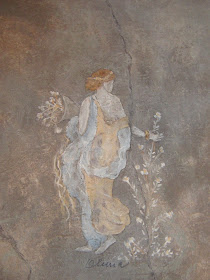HAND PAINTED CHAIR SEAT COVERS & TUTORIAL PAINTING ON CANVAS CLOTH
My client had four very white chairs at her table in her breakfast room. She brought the chairs to me and asked me to paint them a darker color. She only wanted me to paint two of them and gave the other two to me. This picture is one of the chairs that I kept.
I painted the arms, part of the back and front legs a faux dark stained brown wood. I painted the back and back legs an off white, distressed it a bit, painted some ivy on it and aged it with an antiquing glaze. Then, I painted this pot of pink flowers and ivy on canvas cloth and covered the chair seat. I put it for sale in a neat shop that sold lots of my things. After a while, shop owner told me that the pink really wasn't working and asked me if I could paint some blue on it.
I certainly could do that!!
So, I took my paint and supplies, sat on the floor of the shop and changed the pink to blue. Right after that someone bought it. I think they were going to use it for a desk chair.
Oh, and that is a table that I painted and distressed. I love that finish!
The other chair, I had fun with and painted it green with grape vines and painted the canvas chair seat with grapes and wine glasses.
These pictures are for a client who wanted me to paint duck cloth/canvas for her chair back slip covers. She wanted them to be like ancient roman frescoes. After I painted the ladies on the canvas cloth, she had them attached/sewn to a soft white linen fabric with a special trim. The chair seats were made from the soft white linen. The headbands, parts of the flowers and jewelry are painted with metallic gold leaf. They do reflect the light.
The chairs turned out sooo beautifully and I am so proud of them. But, I forgot to take pictures. Maybe someday I will be able to go back and take pictures.
This is another ancient roman fresco I painted for a chair back.
These are patterns I drew and cut out for the chair covers. For this project, it was easier for me to have these patterns. I traced them onto the fabric and painted them. By making the patterns, I was able to draw exactly the right size and place them exactly the way I wanted them on the fabric.
~
TUTORIAL
If you want to change your chair seat covers, it's very simple to do. At your fabric store you will find canvas cloth. You need to choose the strength you think would be good for a chair seat. It's usually 100% cotton, so if you wash it, it will be very, very wrinkled. If that's the look you want, wash it and hang it up to dry. Otherwise, don't wash it and paint right on it like you were painting on any canvas. If you don't want to paint a picture you can use a stencil or paint stripes or plaid, anything you can think of.
My chairs, I turned upside down and unscrewed the chair seats. You can remove the existing seat covers or just fold your canvas cloth right over (without removing the existing seat cover) and staple. BUT, BEFORE I STAPLED THEM, I cut the canvas cloth to the size I needed, leaving lots of extra to fold under. I folded the cloth around the chair seat, placed it back on the chair and put blue tape on the edge of the area to be painted so I would know my boundaries. Next, I took the cloth off the chair, placed it on a table with cardboard under it so the paint wouldn't get on my table. At this point, you can stencil or paint and have fun with your colors and design. Craft paint is inexpensive and comes in sooo many colors and it's ok to use craft paint, if that's easier for you. I always use Textile Medium to thin the paint a little and make sure it penetrates the fabric. It is fabric, so be sure it is totally dry before you start trying to put it on the chair seat. Before you staple, make sure your design is exactly where you want it to be. Then pull it very, very tightly around your chair seat and staple very, very well on the back side. LOTS of staples!
It's sooo easy to do. Have fun!!








Great tutorial, Lynda. You do such beautiful work. I love your ladies especially the last one.
ReplyDelete